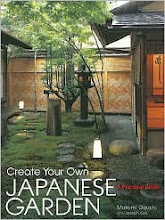There are dozens of changes, albeit small, maybe Lilliputian, but I cherish every one - every new moss, new fern, new pine growth, every new bird that visits. Slow change is a delight.




Some things go in this garden and I know they will change - I want them to change, grow, surprise me. Sometimes I simply know I have planted or placed with hope, and the plant or stone has other intentions. Time will travel them to where they must be and then the right balance will emerge.
Recently I began reconstructing a small section (above) where gravity conspired with terra firma to find their own balance - not mine. I finally followed their lead and rebuilt the entire section of stone, rock and plantings, keeping in mind their wishes.

Thee above image show the section reconstructed and washed.

The final step was to remove all the Mexican blue river stone (more to be added) and was it clean of winter's mud and earth that had fallen down from the banks that would not remain quietly where I intended - oh I have so much to learn. Silent lessons.


Finally to add back the life in the crevices and locations it was deciding. (all the small ferns and mosses were removed before I started the reconstruction and mapped so they would go back as close to their homes as possible.)














